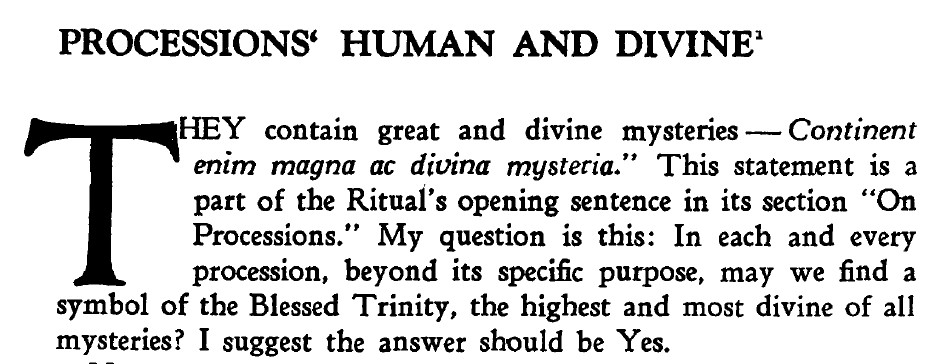 The title caught my eye: “Processions, Human and Divine.” I am very (very!) interested in divine processions: the eternal generation of the Son and the procession of the Holy Spirit. Knowledge of these two processions is knowledge of the Trinity. But what are these “human processions?” My interest piqued, I grabbed the January 1951 issue of Orate Fratres (25/2, pp 64-65) to read about them.
The title caught my eye: “Processions, Human and Divine.” I am very (very!) interested in divine processions: the eternal generation of the Son and the procession of the Holy Spirit. Knowledge of these two processions is knowledge of the Trinity. But what are these “human processions?” My interest piqued, I grabbed the January 1951 issue of Orate Fratres (25/2, pp 64-65) to read about them.
(Don’t ask why I was looking through liturgical journals from the 1950s, okay? Everybody needs hobbies, and I don’t make fun of yours.)
A human procession occurs when a group of people walk in a ceremonial fashion. I get to process… er, proceed… er, participate in a procession several times a year in academic events like Convocations and Commencements and such. I wear Regalia. It’s pretty Grand. And in some liturgies, there are important processions to or from the altar, at the entry of the clergy or choir, etc.
How do these human processions relate to divine processions? Ah, that is the question. And according to an editorial footnote, it’s the question the editor asked after Patrick Cummins, OSB, made the comment that liturgical processions had a deeper theological significance. Cummins’ answer is only two pages long, but I think that might be too long.
They contain great and divine mysteries — Continent enim magna ac divina mysteria. This statement is a part of the Ritual’s opening sentence in its section ‘On Processions.” My question is this: In each and every procession, beyond its specific purpose, may we find a symbol of the Blessed Trinity, the highest and most divine of all mysteries? I suggest the answer should be Yes.
I suggest the author is about to overthink something.
But note how he phrases his question: not “does God intend to communicate something,” or “is a liturgical procession a symbol of the Trinity,” but “may we find…a symbol?” If you take the form of that question literally, the bar is low: are we allowed to perceive something in this ritual action? May we?
Well, Cummins has three points to support his suggestion that we may:
First: Same word. I actually think this is the only connecting point he’s got. It is definitely the same exact word. “A procession, therefore, each and every procession, necessarily reminds the Christian of those eternal Processions which his faith sees in God, the Source and Goal of the two worlds, natural and supernatural, wherein the Christian lives.” It does remind us, because it’s the same word. Then again, that’s going to need to be backed up with something more solid, because an awful lot of words remind me of the Trinity. One time a cashier asked me, “Cash, check, or charge,” and I was instantly transported into contemplation of the three terms of this economic trinity. But sometimes a pun is just a pun.
Second: Processions are connected to missions. “Secondly, the divine Processions lead us to the divine Missions, the Processions being eternal, the Missions temporal, because they terminate in the created order. The Father sends His Son into the world, not from eternity, but in time. The Father and the Son send the Holy Spirit, in visible form, at Pentecost.” I love this whole paragraph (and yes, that was the whole paragraph). But it’s a paragraph about the divine missions. Did Cummins forget to explicate the analogy? Let me fire up the ol’ analogical imagination and try to provide the unstated connection: When humans process/proceed ceremonially, they (usually) carry out their procession inside of the church building. Inside that sacred space, they go from A to B, from terminus a quo to terminus ad quem. Geographically speaking, they have not gone anywhere; they have stayed in church. It’s an internal proceeding, a going-forward that doesn’t go forth outside. But then after the liturgy, the celebrants and the congregation do go forth outside; having gathered and processed liturgically in the holy place, they are sent out on mission to the world. So processions ground missions. Maybe. Cummins doesn’t say. This second point is where some real analytic and comparative work should have been done.
Third: Processions and missions lead to the divine indwelling: “This Indwelling, while it presupposes the natural mystery of the Creator’s presence in all things created, is itself something far higher and more intimate.” And then Cummins says some more great things about the divine indwelling, which is appropriated to the Holy Spirit but is in fact an inhabitation by the entire Trinity.
Those are Cummins’ three reasons for suggesting we may find a symbol of the Trinity in every liturgical procession. “Procession, Mission, Indwelling: these three concatenated mysteries ought to be the enduring conscious possession of each and every Christian.”
Well, yes, they ought. At least that’s what I think and teach.
But aside from the pun (point 1), what it is it about a ceremonial procession that helps a Christian take conscious possession of the “three concatenated mysteries?”
I can admit that I’ve sometimes felt the writerly temptation, when a point I’ve made is argumentatively limp or evidentially thin, to fill things out with some well-turned phrases. It’s a temptation to be resisted. No matter how gorgeous your language, merely declamatory effects are a poor substitute for cogent demonstration.
But Cummins concludes his brief note with a real barn-burner of impassioned praise. After quoting Jesus’ own words about the indwelling of the Trinity (John 14:23), Cummins goes for the glory:
What intimacy these words express! The divine Persons, not absent, but present. Not known abstractly, but quasi-experiment-ally, with the vibrancy of infused charity. And this intimacy, this conscious enjoyment of an indwelling Presence, which supernaturalizes the visible presence of our loved ones, can be cultivated, I suggest, by recognizing that each and every visible procession is picture and symbol of those eternal Processions, which, without beginning and without end, here and now, underlie the indwelling presence of the divine Persons in each living member of the visible procession. That long line of men, women, and children; that musical and measured movement; voices below and bells above; sunlight flooding the scene: all this beautiful world of shape and hue and odor and sweet sound becomes a revelation of a still more beautiful world, the Source and Goal of our creation, redemption, and sanctification, the Blessed Trinity, our intimate possession on earth, and much more wondrously intimate possession in heaven.
Amen and amen! But not so much with the holy strolling queues, which are fine but pretty irrelevant to the grandeur, connected only by a likeness of sounds.
